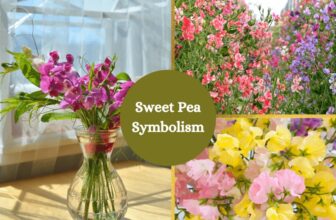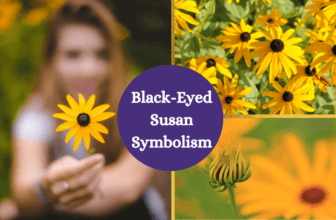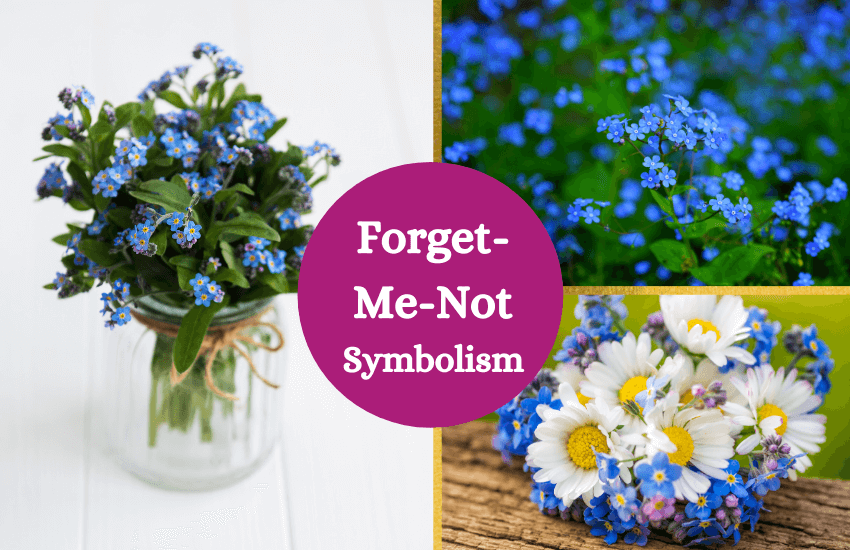
Table of Contents
Most recognized for their dreamy sky blue flowers, forget-me-nots brighten your landscape after the winter months. Here’s what to know about this colorful, versatile plant, along with its rich history and symbolic meanings.
About Forget-me-nots
Native to Europe, forget-me-nots are dainty flowers from the Myosotis genus of the Boraginaceae family. The botanical name is derived from the Greek terms mus that means mouse, and otis or ous that translates to ear, since its leaves resemble a mouse’s ears. The common name comes from the German vergissmeinnicht that means forget-me-not.
These flowers are just some of the few flowers that can boast a truly blue color, though they can also be seen in white and pink, with yellow centers. Forget-me-nots thrive in moist places, even on waste grounds and roadsides. While the M. sylvatica variety grows in the mountain grasslands and woodlands, the M. scorpioides is commonly found near ponds and streams.
- Interesting Fact: During the 16th century, the flower was commonly called mouse ear—but thankfully the name was eventually changed to forget-me-not by the 19th century. Also, it shouldn’t be confused with its relative plants – Italian and Siberian bugloss, dubbed the false forget-me-nots, as they also have vivid blue flowers.
A German Folktale about the Forget-me-not Flower
The story behind the forget-me-not’s name comes from a German folktale. Once upon a time, a knight and his lady were strolling along the riverbank, when they came across the beautiful sky-blue blossoms. They admired the beauty of the flowers, so the knight attempted to pick the flowers for his beloved.
Unfortunately, he was wearing his heavy armor, so he fell in the waters and was swept away by the river. Before being drowned, he threw the posy to his beloved, and cried out, “Forget me not!” It’s thought that the lady wore the blossoms on her hair until the day she died. Since then, the dainty blooms became associated with remembrance and true love.
Meaning and Symbolism of the Forget-me-nots
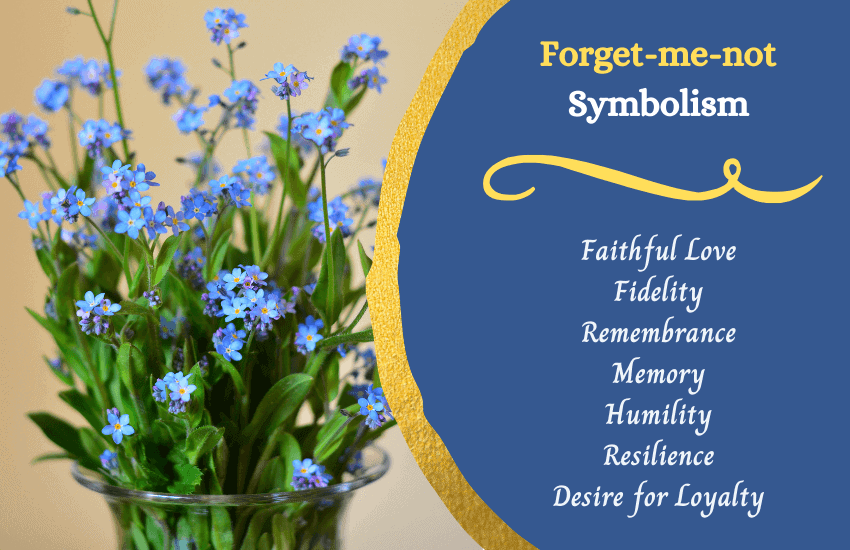
- Faithful Love and Fidelity – Forget-me-nots symbolize loyalty and faithful love, likely because of its association with the German folktale. It’s thought that lovers who exchange bouquets of forget-me-nots on parting will eventually be reunited. It can also show that someone is clinging to a past love.
- Remembrance and Memory – Just as the name implies, forget-me-nots symbolize remembrance. The bloom simply says, “I will never forget you,” and “Do not forget me.” In some contexts, forget-me-nots can represent good memories of a loved one, which will be long remembered. Many believe that forget-me-nots bloomed on the battlefields of Waterloo in 1815, which likely contributed to the meaning of the flower. In France, it’s thought that when you plant forget-me-nots on the grave of your loved ones, the flowers will bloom as long as you live.
- Humility and Resilience – These blossoms grow in marshy lands such as streams and pond edges, yet bear clusters of delicate, blue flowers. In this respect, they symbolize humility and resilience.
- In some contexts, forget-me-nots are associated with secrecy and a desire for loyalty.
Uses of Forget-me-nots throughout History
For centuries, the flowers have been the subject of many literary works, and became symbolic in various regions and organizations.
As a Sentimental Flower
In history, it has been associated with remembering loved ones, as well as fallen soldiers in war. It’s said that people would wear them on their hair or even grow them in the gardens to show their faithfulness to their partner. Did you know forget-me-nots were Princess Diana’s favorite blooms? In fact, there are lots of them planted in the gardens of London’s Kensington Palace in honor of her.
In Medicine
Disclaimer
John Gerard, an English Jesuit priest during the Elizabethan era, believed that forget-me-nots cured scorpion bites, so he named the flower scorpion grass. However, scorpions aren’t common in England. Also, some varieties of the flower were made in syrup for treating cough and other lung diseases.
In Gastronomy
Certain varieties of forget-me-nots are edible, and can be incorporated into salads, candies and baked goods to add color and interest. However, it’s said that the bloom still contains a mildly toxic chemical that’s harmful when ingested in large amounts.
In Literature
Forget-me-nots have been featured in many poems, novels and epics. In The Writings of Henry David Thoreau, forget-me-nots were described as something beautiful and unpretending.
In Emblems and as State Flower
It’s said that Henry IV of England adopted the flower as his personal emblem. In 1917, the Alpine forget-me-not became the official flower of Alaska, since it covers the landscape during its blooming season.
In 1926, forget-me-nots were used as a Masonic emblem and eventually made its way into the organization’s badges, which once regarded as the secret identification of membership, and now commonly seen on coat lapels of Freemasons.
The Forget-me-not Flower in Use Today
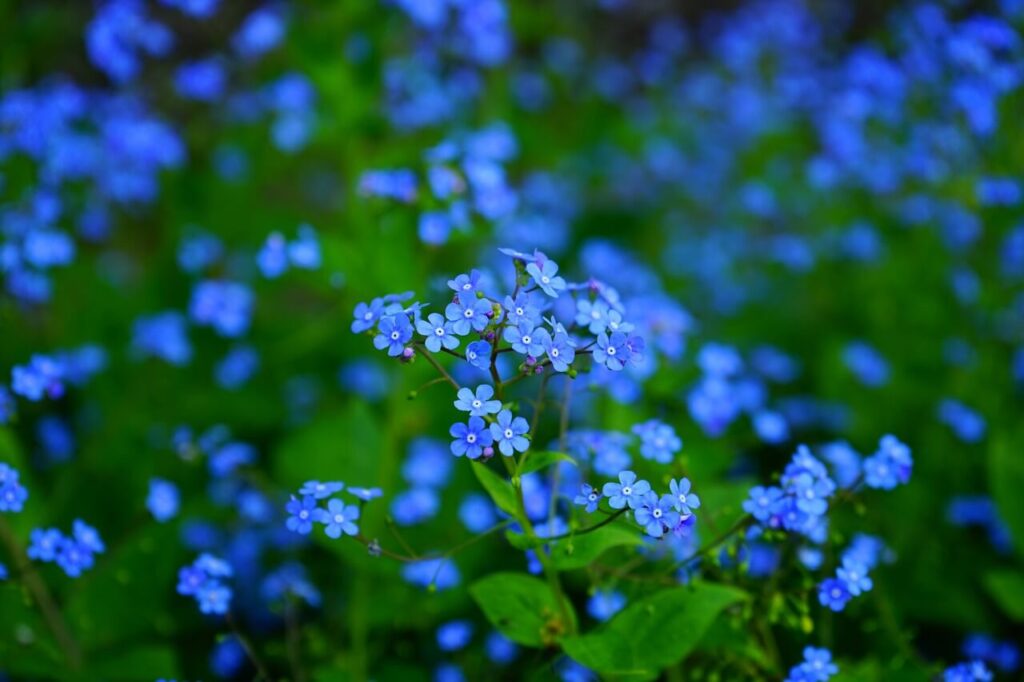
These dainty blooms grow easily, making them the perfect plant for border fronts, rock and cottage gardens, as well as ground covers. A great thing is that they complement other spring flowers and can serve as a beautiful backdrop for taller blooms. While growing them in pots and containers isn’t the most ideal use of forget-me-nots, it can still be a creative option so you can display them on patios and decks.
If you want to make your big day more meaningful, think of these blooms! Apart from adding a pop of color to your wedding bouquet and décor, forget-me-nots will add a touch of sentimentality to the occasion. They’re also ideal as your ‘something blue’. They’re a great filler flower in any arrangement, and will look dreamy in boutonnieres, centerpieces and wedding arch!
When to Give Forget-me-nots
Since these blooms are a symbol of faithfulness and love, they’re an ideal present for anniversaries, engagement, Valentine’s Day, and any romantic celebration. A bouquet of forget-me-nots can also be a thoughtful birthday gift, a token of friendship, or even a sentimental going away gift. You’re simply saying, “Remember me forever.”
It can also inspire those with family members who have Alzheimer’s disease or dementia. Also, its name itself and symbolism make it one of the best flowers for condolences. In some cultures, forget-me-not seeds are given to friends and family to plant at home, in hopes of keeping the memory of someone alive. They can be perfect for any occasion to make someone’s day more special!
In Brief
These bright blue flowers will turn any modest front yard into something colorful and beautiful. As a symbol of faithful love and remembrance, forget-me-nots will never lose their appeal.





